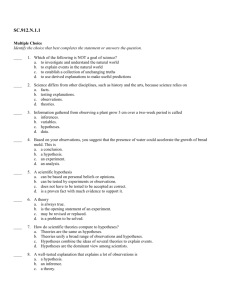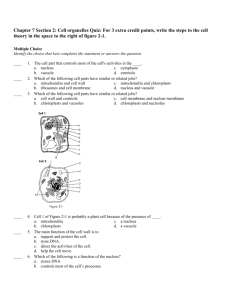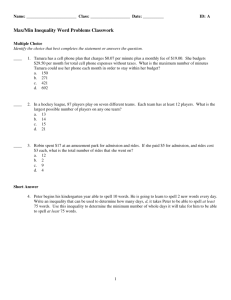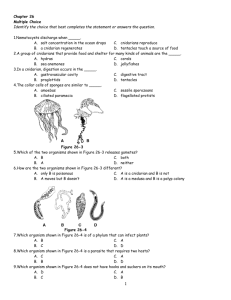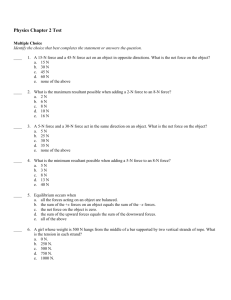Ch 16 test review
advertisement
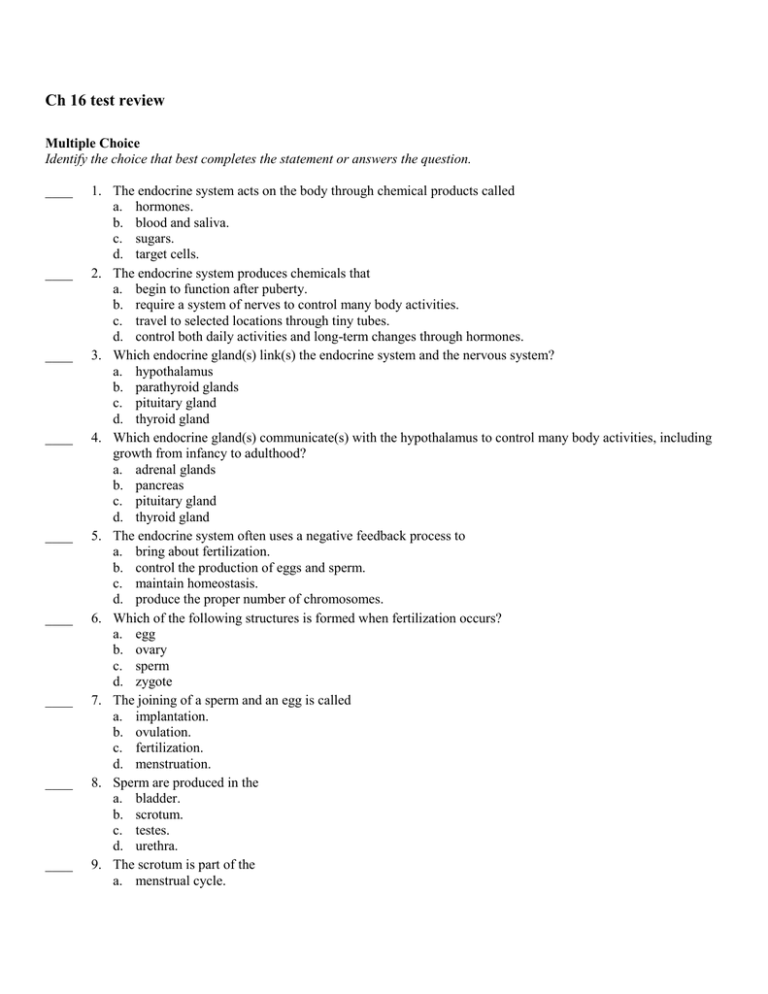
Ch 16 test review Multiple Choice Identify the choice that best completes the statement or answers the question. ____ ____ ____ ____ ____ ____ ____ ____ ____ 1. The endocrine system acts on the body through chemical products called a. hormones. b. blood and saliva. c. sugars. d. target cells. 2. The endocrine system produces chemicals that a. begin to function after puberty. b. require a system of nerves to control many body activities. c. travel to selected locations through tiny tubes. d. control both daily activities and long-term changes through hormones. 3. Which endocrine gland(s) link(s) the endocrine system and the nervous system? a. hypothalamus b. parathyroid glands c. pituitary gland d. thyroid gland 4. Which endocrine gland(s) communicate(s) with the hypothalamus to control many body activities, including growth from infancy to adulthood? a. adrenal glands b. pancreas c. pituitary gland d. thyroid gland 5. The endocrine system often uses a negative feedback process to a. bring about fertilization. b. control the production of eggs and sperm. c. maintain homeostasis. d. produce the proper number of chromosomes. 6. Which of the following structures is formed when fertilization occurs? a. egg b. ovary c. sperm d. zygote 7. The joining of a sperm and an egg is called a. implantation. b. ovulation. c. fertilization. d. menstruation. 8. Sperm are produced in the a. bladder. b. scrotum. c. testes. d. urethra. 9. The scrotum is part of the a. menstrual cycle. ____ 10. ____ 11. ____ 12. ____ 13. ____ 14. ____ 15. ____ 16. ____ 17. ____ 18. b. endocrine system. c. female reproductive system. d. male reproductive system. Eggs are produced in the a. ovaries. b. fallopian tubes. c. uterus. d. vagina. Human eggs are usually fertilized in the a. uterus. b. fallopian tube. c. ovary. d. cervix. A mature egg is released from the ovary during a process called a. fallopian tube. b. ovulation. c. menstruation. d. fertilization. In a female’s body, an egg develops in an ovary, and the uterus prepares for the arrival of a fertilized egg during a. homeostasis. b. labor and delivery. c. pregnancy. d. the menstrual cycle. When a human egg is not fertilized, extra blood and tissue from the uterus are released through the vagina in a process called a. menstruation. b. elimination. c. ovulation. d. reproduction. Where does a fertilized egg develop after it leaves the fallopian tube? a. the cervix b. the ovary c. the uterus d. the vagina Which of the following describes the first nine months of human development in the correct order? a. egg, sperm, zygote b. embryo, fetus, afterbirth c. zygote, embryo, fetus d. zygote, fetus, embryo Eating a healthy diet while pregnant is important because a. nutrients from the mother help protect the fetus from dangerous chemicals. b. nutrients from the mother pass directly to the fetus through the placenta. c. proper nutrition will make the child a picky eater in the future. d. a healthy diet will prevent viruses from passing through the placenta to the fetus. What happens during the stage of childbirth called labor? a. Strong muscle contractions push the baby out of the mother’s body. b. The fetus develops a heartbeat, its bones become distinct, and it begins to move. c. The umbilical cord is tied, then cut a few centimeters away from the baby’s abdomen. ____ 19. ____ 20. ____ 21. ____ 22. ____ 23. d. Strong muscle contractions of the uterus cause the cervix to enlarge. What happens during the stage of childbirth called delivery? a. Muscle contractions push the placenta out of the mother’s body. b. The baby comes out of the mother’s body. c. The lining of the uterus thickens in preparation for the arrival of a zygote. d. A zygote with the proper number of chromosomes is formed. Which period makes up the stage of development called childhood? a. birth to age 7 b. birth to age 10 c. ages 7 to about 10 d. ages 2 to about 12 What is the main event that happens during puberty? a. Individuals begin to ask questions about their future. b. Individuals need large amounts of food because of rapid growth. c. Individuals may feel pain because their bodies grow so rapidly. d. An individual’s body becomes able to reproduce. During which period of development does a person’s thinking mature and become more like an adult? a. adulthood b. adolescence c. childhood d. infancy Which of the following is the best description of adolescence? a. the stage when children become adults physically and mentally b. the stage when individuals first produce hormones c. the stage that’s the same as puberty d. the stage when people have “growing pains” Modified True/False Indicate whether the statement is true or false. If false, change the identified word or phrase to make the statement true. ____ 24. The organs of the endocrine system produce chemical messengers called enzymes. _________________________ ____ 25. The male sex cell is called a sperm. _________________________ ____ 26. Sex cells contain twice as many chromosomes as other body cells. _________________________ ____ 27. The release of a mature egg into a fallopian tube is called menstruation. _________________________ ____ 28. During the first eight weeks after fertilization, a developing human is known as a(n) embryo. _________________________ ____ 29. Labor involves strong muscular contractions of the fallopian tubes. _________________________ ____ 30. Identical twins develop from two different eggs that are fertilized by different sperm. _________________________ ____ 31. During infancy, humans learn to feed themselves and play with toys. _________________________ ____ 32. The time between childhood and adulthood is called adolescence. _________________________ ____ 33. One typical social change during early childhood is that individuals begin to take on adult responsibilities. _________________________ Completion Complete each statement. 34. The endocrine gland called the ____________________ gland communicates with the hypothalamus to control many body activities. 35. A hormone released by the ____________________ glands controls the amount of calcium in the blood. 36. The thyroid and pituitary are part of the ____________________ system. 37. The endocrine system maintains ____________________, or internal balance, through negative feedback. 38. The endocrine system controls the amount of a particular ____________________ in the blood by stopping its release when it reaches a certain level. 39. A sperm and egg join to form a fertilized egg, which is called a(n) ____________________. 40. The hormone ____________________ controls the development of male characteristics. 41. Sperm are produced in the organs called ____________________. 42. One important function of ovaries is to produce ____________________ cells. 43. Fertilization usually takes place in the ____________________, or passageways for eggs. 44. The monthly cycle of changes in the female reproductive system is called the ____________________ cycle. 45. During the menstrual cycle, the lining of the ____________________ builds up with extra blood and tissue to prepare for a fertilized egg. 46. A developing human is called a(n) ____________________ between the ninth week of development and birth. 47. The baby is pushed out of the uterus during ____________________, or the second stage of birth. 48. Contractions push the placenta out of the mother’s body during the stage of birth known as ____________________. 49. A human usually learns to walk during the stage of development known as ____________________. 50. A person might have his or her first jobs, start to manage his or her own money, and develop more complex social relationships during the stage of development known as ____________________. 51. The period of development during which a person becomes physically able to reproduce is called ____________________. 52. Adolescence includes ____________________ changes as well as physical changes. 53. During the period of life called ____________________, language skills develop, and individuals learn to communicate and carry on conversations. Short Answer 54. What hormone does the pituitary release? What organ signals the pituitary to release this hormone? 55. The diagram uses a model to show how the release of thyroxine is controlled. What happens at point A? 56. The diagram uses a model to show how the release of thyroxine is controlled. What happens at point B? 57. What event makes the hypothalamus sense that body cells need more energy? 58. What is the function of the hormone thyroxine? 59. Why is the cycle illustrated in this diagram called a negative feedback system? Use the diagram to answer each question. 60. Identify structure A and explain its function. 61. Which structure—A, B, C, D, or E—is NOT involved either in protecting the fetus or supplying the fetus with what it needs to survive and develop? 62. Identify structure C and describe its function. 63. What is structure B? How does it protect the fetus? 64. Suppose structure C became damaged. What effect would this have on the fetus? 65. What is structure D? What does it do during delivery? Ch 16 test review Answer Section MULTIPLE CHOICE 1. ANS: OBJ: STA: 2. ANS: OBJ: STA: 3. ANS: OBJ: BLM: 4. ANS: OBJ: BLM: 5. ANS: OBJ: STA: 6. ANS: OBJ: BLM: 7. ANS: OBJ: BLM: 8. ANS: OBJ: STA: 9. ANS: OBJ: STA: 10. ANS: OBJ: STA: 11. ANS: OBJ: STA: 12. ANS: OBJ: STA: 13. ANS: OBJ: STA: 14. ANS: OBJ: STA: 15. ANS: A PTS: 1 DIF: L2 CaLS.16.1.1 Describe how the endocrine system controls body processes. S 7.5.b BLM: comprehension D PTS: 1 DIF: L1 CaLS.16.1.1 Describe how the endocrine system controls body processes. S 7.5.b BLM: knowledge A PTS: 1 DIF: L2 CaLS.16.1.2 Identify the endocrine glands. STA: S 7.5.b comprehension C PTS: 1 DIF: L1 CaLS.16.1.2 Identify the endocrine glands. STA: S 7.5.b knowledge C PTS: 1 DIF: L1 CaLS.16.1.3 Explain how negative feedback controls hormone levels. S 7.5.b BLM: knowledge D PTS: 1 DIF: L1 CaLS.16.2.1 Define sexual reproduction. STA: S 7.5.d knowledge C PTS: 1 DIF: L1 CaLS.16.2.1 Define sexual reproduction. STA: S 7.5.d knowledge C PTS: 1 DIF: L1 CaLS.16.2.2 Describe the structures and functions of the male reproductive system. S 7.5.d BLM: knowledge D PTS: 1 DIF: L1 CaLS.16.2.2 Describe the structures and functions of the male reproductive system. S 7.5.d BLM: knowledge A PTS: 1 DIF: L1 CaLS.16.2.3 Describe the structures and functions of the female reproductive system. S 7.5.d BLM: knowledge B PTS: 1 DIF: L1 CaLS.16.2.3 Describe the structures and functions of the female reproductive system. S 7.5.d BLM: knowledge B PTS: 1 DIF: L1 CaLS.16.2.4 Sequence the events that occur during the menstrual cycle. S 7.5.d BLM: knowledge D PTS: 1 DIF: L1 CaLS.16.2.4 Sequence the events that occur during the menstrual cycle. S 7.5.d BLM: knowledge A PTS: 1 DIF: L1 CaLS.16.2.4 Sequence the events that occur during the menstrual cycle. S 7.5.d BLM: knowledge C PTS: 1 DIF: L1 16. 17. 18. 19. 20. 21. 22. 23. OBJ: STA: ANS: OBJ: STA: ANS: OBJ: STA: ANS: OBJ: BLM: ANS: OBJ: BLM: ANS: OBJ: STA: ANS: OBJ: STA: ANS: OBJ: STA: ANS: OBJ: STA: CaLS.16.3.1 List the changes that occur to the zygote, embryo, and fetus during development. S 7.1.f BLM: knowledge C PTS: 1 DIF: L2 CaLS.16.3.1 List the changes that occur to the zygote, embryo, and fetus during development. S 7.1.f BLM: comprehension B PTS: 1 DIF: L3 CaLS.16.3.2 Explain how the developing embryo is protected and nourished. S 7.5.e BLM: synthesis D PTS: 1 DIF: L2 CaLS.16.3.3 Describe what happens during childbirth. STA: S 7.5.b comprehension B PTS: 1 DIF: L2 CaLS.16.3.3 Describe what happens during childbirth. STA: S 7.5.b comprehension D PTS: 1 DIF: L2 CaLS.16.3.4 Identify changes that occur from infancy to adulthood. S 7.1.f BLM: comprehension D PTS: 1 DIF: L1 CaLS.16.3.4 Identify changes that occur from infancy to adulthood. S 7.1.f BLM: knowledge B PTS: 1 DIF: L2 CaLS.16.3.4 Identify changes that occur from infancy to adulthood. S 7.1.f BLM: comprehension A PTS: 1 DIF: L2 CaLS.16.3.4 Identify changes that occur from infancy to adulthood. S 7.1.f BLM: comprehension MODIFIED TRUE/FALSE 24. ANS: F, hormones PTS: OBJ: STA: 25. ANS: OBJ: BLM: 26. ANS: 1 DIF: L2 CaLS.16.1.1 Describe how the endocrine system controls body processes. S 7.5.b BLM: knowledge T PTS: 1 DIF: L1 CaLS.16.2.1 Define sexual reproduction. STA: S 7.5.d knowledge F, half PTS: 1 STA: S 7.5.d 27. ANS: F, ovulation PTS: OBJ: STA: 28. ANS: OBJ: STA: DIF: L1 BLM: knowledge OBJ: CaLS.16.2.1 Define sexual reproduction. 1 DIF: L1 CaLS.16.2.4 Sequence the events that occur during the menstrual cycle. S 7.5.d BLM: knowledge T PTS: 1 DIF: L1 CaLS.16.3.1 List the changes that occur to the zygote, embryo, and fetus during development. S 7.1.f BLM: knowledge 29. ANS: F, uterus PTS: 1 STA: S 7.5.b 30. ANS: F, Fraternal PTS: STA: 31. ANS: OBJ: STA: 32. ANS: OBJ: STA: 33. ANS: DIF: L1 BLM: knowledge OBJ: CaLS.16.3.3 Describe what happens during childbirth. 1 DIF: L1 OBJ: CaLS.16.3.3 Describe what happens during childbirth. S 7.2.b BLM: knowledge T PTS: 1 DIF: L1 CaLS.16.3.4 Identify changes that occur from infancy to adulthood. S 7.1.f BLM: knowledge T PTS: 1 DIF: L1 CaLS.16.3.4 Identify changes that occur from infancy to adulthood. S 7.1.f BLM: knowledge F, adolescence PTS: 1 DIF: L1 OBJ: CaLS.16.3.4 Identify changes that occur from infancy to adulthood. STA: S 7.1.f BLM: knowledge COMPLETION 34. ANS: pituitary PTS: OBJ: STA: 35. ANS: 1 DIF: L1 CaLS.16.1.1 Describe how the endocrine system controls body processes. S 7.5.b BLM: knowledge parathyroid PTS: 1 STA: S 7.5.b 36. ANS: endocrine DIF: L1 BLM: knowledge OBJ: CaLS.16.1.2 Identify the endocrine glands. PTS: 1 STA: S 7.5.b 37. ANS: homeostasis DIF: L1 BLM: knowledge OBJ: CaLS.16.1.2 Identify the endocrine glands. PTS: OBJ: STA: 38. ANS: 1 DIF: L2 CaLS.16.1.3 Explain how negative feedback controls hormone levels. S 7.5.b BLM: comprehension hormone PTS: OBJ: STA: 39. ANS: 1 DIF: L2 CaLS.16.1.3 Explain how negative feedback controls hormone levels. S 7.5.b BLM: comprehension zygote PTS: 1 STA: S 7.5.d DIF: L1 BLM: knowledge OBJ: CaLS.16.2.1 Define sexual reproduction. 40. ANS: testosterone PTS: OBJ: STA: 41. ANS: 1 DIF: L1 CaLS.16.2.2 Describe the structures and functions of the male reproductive system. S 7.5.d BLM: knowledge testes PTS: OBJ: STA: 42. ANS: 1 DIF: L1 CaLS.16.2.2 Describe the structures and functions of the male reproductive system. S 7.5.d BLM: knowledge egg PTS: OBJ: STA: 43. ANS: 1 DIF: L1 CaLS.16.2.3 Describe the structures and functions of the female reproductive system. S 7.5.d BLM: knowledge fallopian tubes PTS: OBJ: STA: 44. ANS: 1 DIF: L2 CaLS.16.2.3 Describe the structures and functions of the female reproductive system. S 7.5.d BLM: comprehension menstrual PTS: OBJ: STA: 45. ANS: 1 DIF: L1 CaLS.16.2.4 Sequence the events that occur during the menstrual cycle. S 7.5.d BLM: knowledge uterus PTS: OBJ: STA: 46. ANS: 1 DIF: L2 CaLS.16.2.4 Sequence the events that occur during the menstrual cycle. S 7.5.d BLM: comprehension fetus PTS: OBJ: STA: 47. ANS: 1 DIF: L1 CaLS.16.3.1 List the changes that occur to the zygote, embryo, and fetus during development. S 7.1.f BLM: knowledge delivery PTS: 1 STA: S 7.5.b 48. ANS: afterbirth DIF: L1 BLM: knowledge OBJ: CaLS.16.3.3 Describe what happens during childbirth. PTS: 1 STA: S 7.5.e 49. ANS: infancy DIF: L1 BLM: knowledge OBJ: CaLS.16.3.3 Describe what happens during childbirth. PTS: OBJ: STA: 50. ANS: 1 DIF: L1 CaLS.16.3.4 Identify changes that occur from infancy to adulthood. S 7.1.f BLM: knowledge adolescence PTS: OBJ: STA: 51. ANS: 1 DIF: L3 CaLS.16.3.4 Identify changes that occur from infancy to adulthood. S 7.1.f BLM: application puberty PTS: OBJ: STA: 52. ANS: 1 DIF: L1 CaLS.16.3.4 Identify changes that occur from infancy to adulthood. S 7.1.f BLM: knowledge mental PTS: OBJ: STA: 53. ANS: 1 DIF: L2 CaLS.16.3.4 Identify changes that occur from infancy to adulthood. S 7.1.f BLM: comprehension childhood PTS: 1 DIF: L2 OBJ: CaLS.16.3.4 Identify changes that occur from infancy to adulthood. STA: S 7.1.f BLM: comprehension SHORT ANSWER 54. ANS: The pituitary releases the hormone TSH because the hypothalamus signals it to do so. PTS: 1 DIF: L2 OBJ: CaLS.16.1.3 Explain how negative feedback controls hormone levels. STA: S 7.5.b BLM: comprehension 55. ANS: The pituitary stops producing TSH. PTS: 1 DIF: L2 OBJ: CaLS.16.1.3 Explain how negative feedback controls hormone levels. STA: S 7.5.b BLM: analysis 56. ANS: The thyroid gland produces the hormone thyroxine. PTS: 1 DIF: L2 OBJ: CaLS.16.1.3 Explain how negative feedback controls hormone levels. STA: S 7.5.b BLM: analysis 57. ANS: The thyroid gland stops producing the hormone thyroxine. PTS: 1 DIF: L3 OBJ: CaLS.16.1.3 Explain how negative feedback controls hormone levels. STA: S 7.5.b BLM: comprehension 58. ANS: Thyroxine controls how much energy is available to cells. PTS: 1 DIF: L2 OBJ: CaLS.16.1.3 Explain how negative feedback controls hormone levels. STA: S 7.5.b BLM: comprehension 59. ANS: The cycle is a negative feedback system because the condition it produces (making energy available to cells) turns the system off. When the amount of thyroxine reaches a high enough level to supply the cells with enough energy, the endocrine system signals the thyroid gland to stop releasing thyroxine. PTS: 1 DIF: L2 OBJ: CaLS.16.1.3 Explain how negative feedback controls hormone levels. STA: S 7.5.b BLM: analysis 60. ANS: A is the placenta. It is the structure through which the fetus receives oxygen and food from the mother. Wastes from the fetus pass through the placenta to the mother. PTS: 1 DIF: L2 OBJ: CaLS.16.3.2 Explain how the developing embryo is protected and nourished. STA: S 7.5.e BLM: application 61. ANS: E, the vagina PTS: 1 DIF: L2 OBJ: CaLS.16.3.2 Explain how the developing embryo is protected and nourished. STA: S 7.5.b BLM: application 62. ANS: C is the umbilical cord. It connects the fetus to the placenta. The umbilical cord contains blood vessels that transport food, oxygen, and wastes between the fetus and the mother. PTS: 1 DIF: L2 OBJ: CaLS.16.3.2 Explain how the developing embryo is protected and nourished. STA: S 7.5.b BLM: application 63. ANS: The fluids in B, the amniotic sac, cushion and protect the fetus from injury. PTS: 1 DIF: L2 OBJ: CaLS.16.3.2 Explain how the developing embryo is protected and nourished. STA: S 7.5.b BLM: application 64. ANS: If C, the umbilical cord, were damaged, it would interfere with the transferring of materials between the placenta and the fetus. The fetus would probably not survive if it could not receive necessary materials or have wastes removed. PTS: 1 DIF: L3 OBJ: CaLS.16.3.2 Explain how the developing embryo is protected and nourished. STA: S 7.5.e BLM: synthesis 65. ANS: D is the uterus. During delivery, it undergoes strong muscular contractions that push the baby out of the uterus, through the vagina, and out of the mother’s body. PTS: 1 STA: S 7.5.b DIF: L2 BLM: application OBJ: CaLS.16.3.3 Describe what happens during childbirth.


